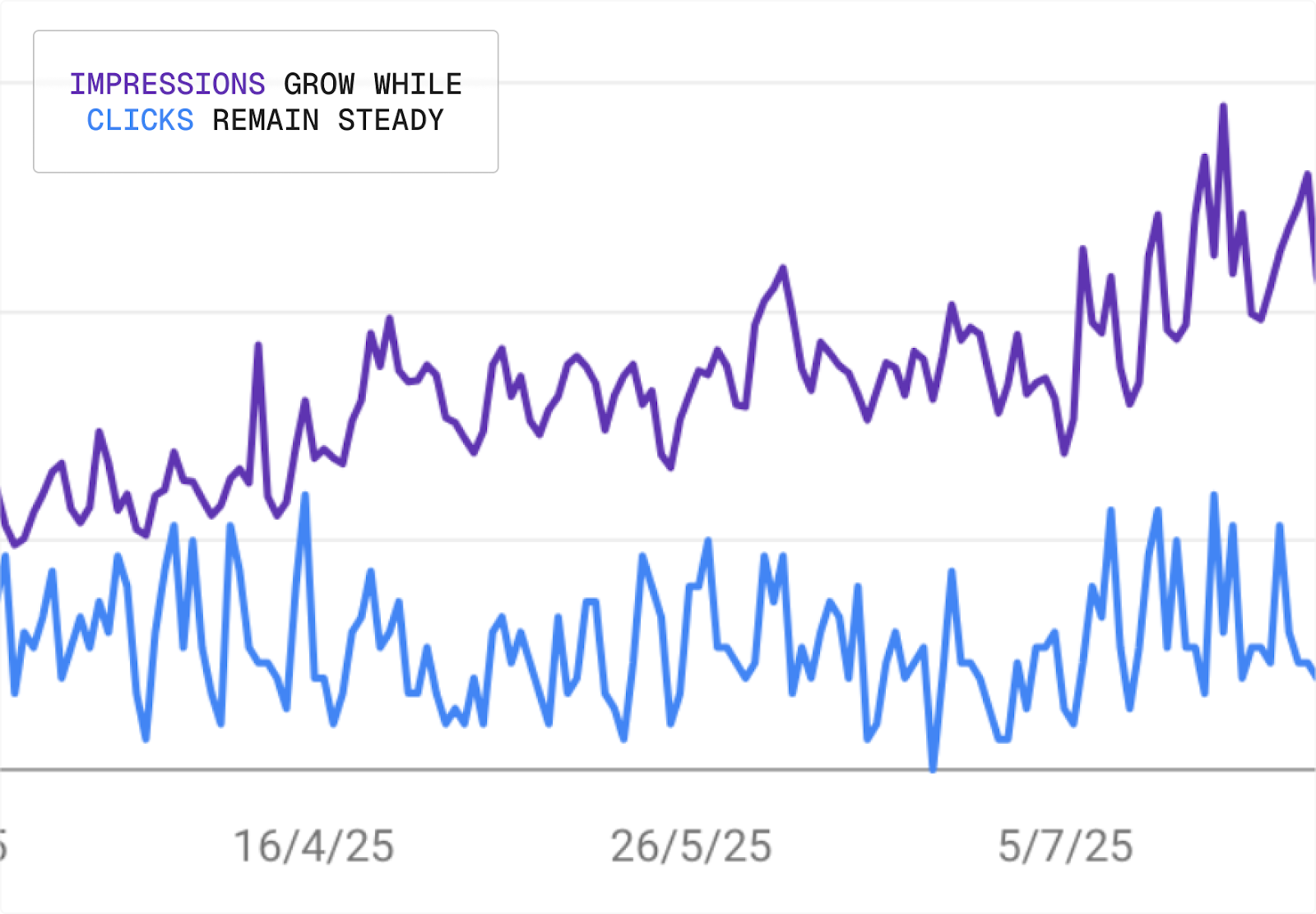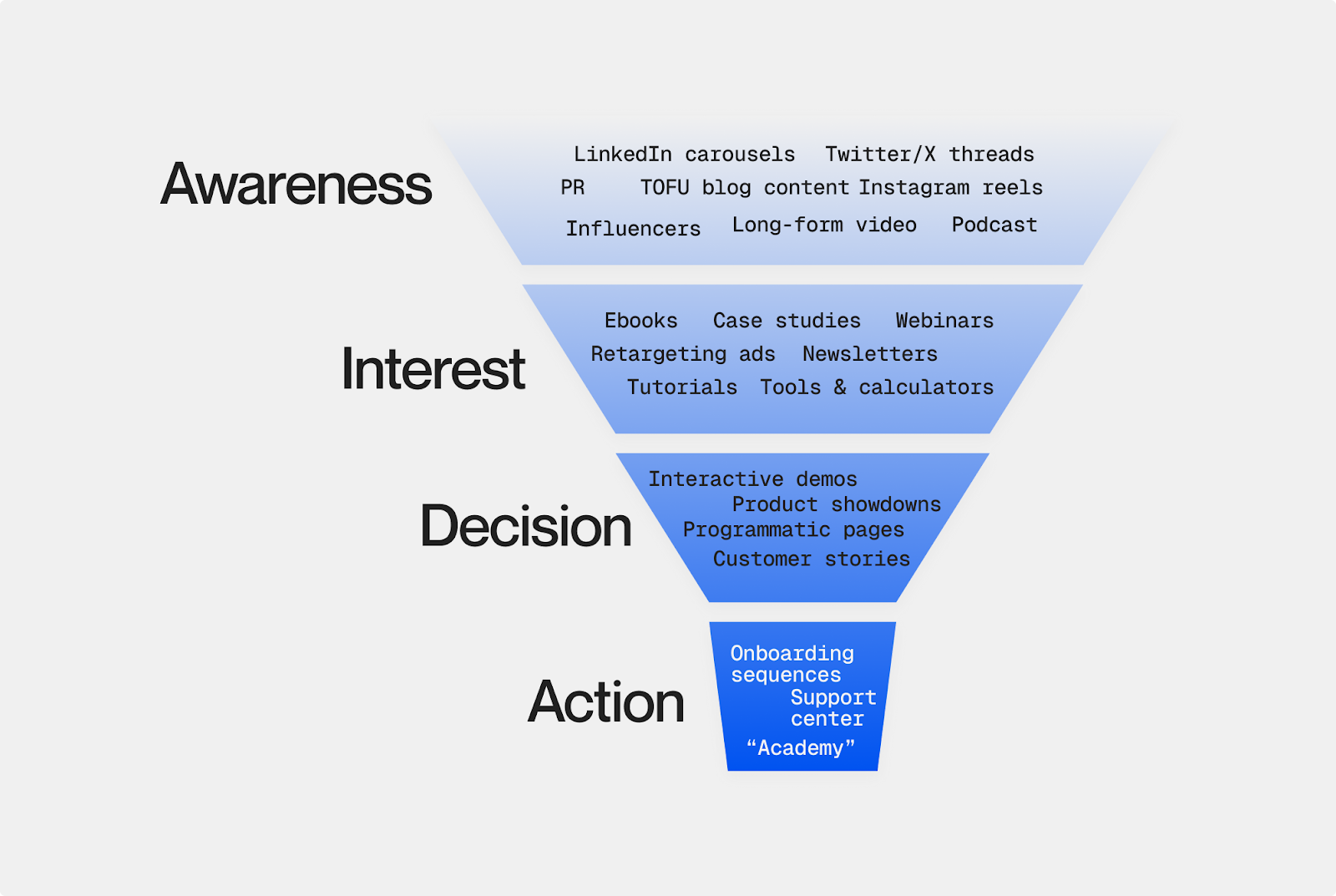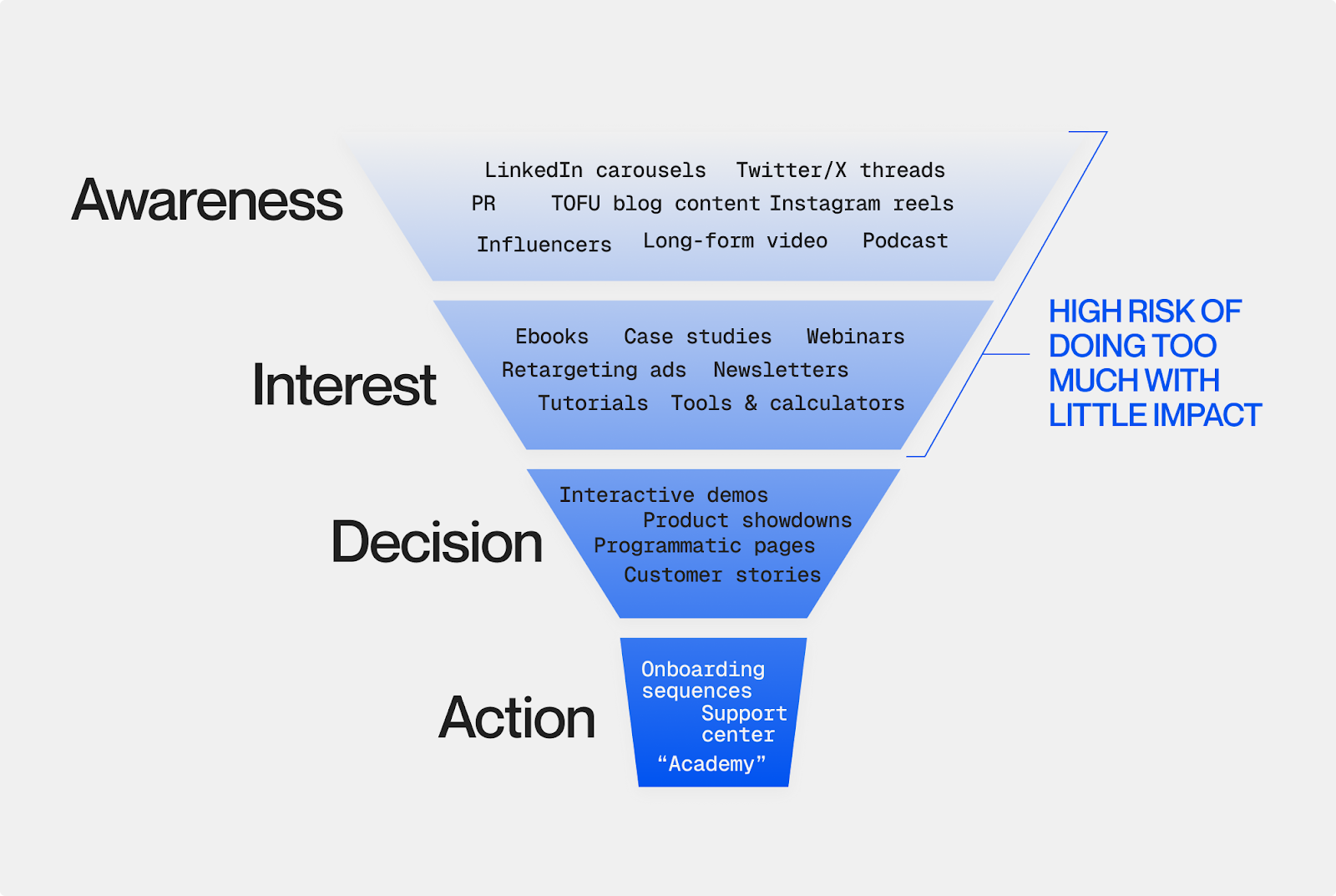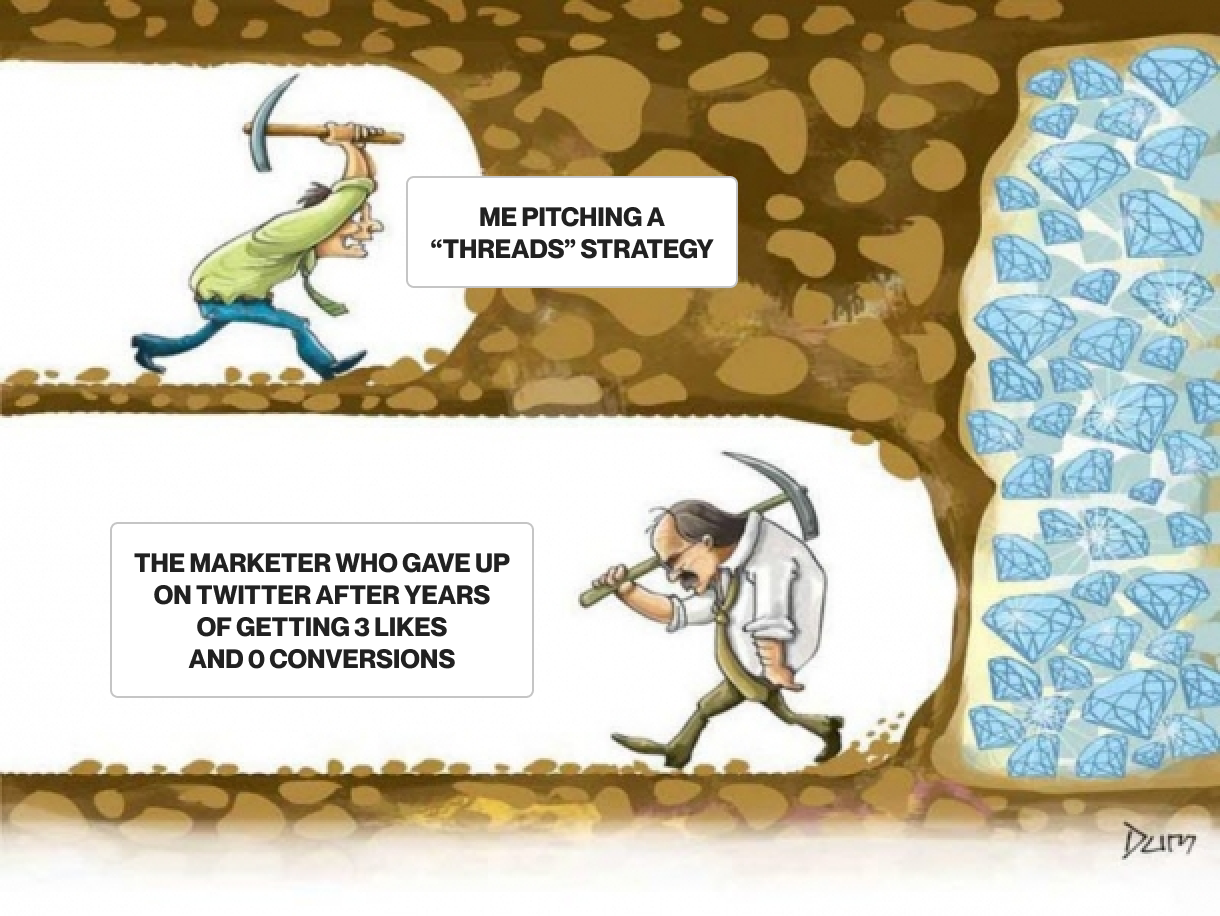A Growth Formula for the Walled Garden Internet
Get weekly strategy insights by our best humans

This time it's for real, digital marketing is in crisis. This crisis has four key symptoms:
- Decreased social media engagement - which prevents more users from discovering your brand.
- Decreased social media ad ROI - which threatens one of the greatest tools in the digital marketing arsenal. "If organic doesn't work, you can just throw money at the problem, right?"
- Decreased organic traffic - which prevents qualified leads from entering your website (where you can show them your best content, identify them, and engage them).
- Decreased conversions - which is bad news.
If we had to synthesize these symptoms down to two big problems, we could refer to:
- The inability to "stop the scroll" and get users to pay attention.
- The inability to funnel traffic to websites.
The reason behind this crisis is that former traffic sources are becoming walled gardens - and those walled gardens are getting filled with AI slop.
In this post, we'll cover:
- The definition of "walled garden" and some examples
- How to build a marketing funnel in the walled garden internet
- What makes content competitive in this new era
Let's dive in.
Something important, before moving on: Although I'd love for these insights to be useful to marketers across niches, I specialize in selling software, so most of my insights will be biased in that direction. For e-commerce, the playbook would be slightly different.
What's a walled garden?
A walled garden is a closed ecosystem that's fully managed by a single company. This company has control over:
- User experience
- Integrations
- Data
Users on walled gardens are discouraged from leaving the platform, with outbound links being restricted or deboosted.
Walled garden examples
Walled gardens are all around us. Look at:
- Facebook - The platform changed its strategy in 2016, causing publishers to lose massive amounts of traffic.
- Instagram - In spite of being a great platform, IG disables external links on post copy and comments, forcing users to rely on "link[s] in bio".
- TikTok - The home of short video leverages user data for content curation and targeted advertising, aiming to control everything from content discovery to audience monetization.
- Amazon - The e-commerce titan fully controls the experiences of both customers and sellers.
It's very common for social platforms to begin as great content distribution channels, bringing tons of quality traffic to publishers, and become walled gardens as their user base grows.
How Google became a walled garden
Generative AI gifted Google the right context and tooling to become a walled garden. It's true: It's been a long time since the Google SERPs were just a series of blue links. SERP features have been taking traffic away from publishers for some time. But AI overviews' effect on organic traffic is unprecedented. Zero-click searches now make up 60% of all searches. Want to see the impact?

Rising impressions, plummeting or stable traffic. Some SEOs have hilariously begun calling this type of graphic “crocodile mouth”.
We’re not dentists, nor veterinarians - but the cure for crocodile mouth may be a call away.
How to build a marketing funnel for the walled garden internet
Back in the day, a marketing funnel could look something like this:

And some companies can still make it work. Especially those with generous marketing resources. But what about a startup that's just starting out - or beginning to see its growth threatened by their inability to get users to their website? In this day and age, what's the optimal marketing funnel structure for a startup that's in its early stage... or struggling to build sustainable growth levers?
The key problem area is TOFU

The key problem area is top of funnel. We’re stuck in the increasingly claustrophobic dynamics of walled gardens, with engagement rates falling—driven mostly by content saturation and the difficulty users face in telling signal from noise. The result is a scenario where marketing teams are very prone to what we call “spray and pray.” If Instagram isn’t working, let’s try Twitter. If Twitter isn’t working, let’s try LinkedIn. And by the end of the day, you’re just reposting the same piece of content across different channels, with nothing really hitting.
The alternative isn’t much better. If you try to get more precise and build strategies specific to each channel, you end up going mad—managing these gargantuan workflows where a single piece of content gets chopped into ten or twelve variations. Most of those formats underperform, but you keep producing them just in case the next one goes viral.

It’s like that meme with the diamond mine: one guy charging ahead in a frenzy toward the diamonds, while another gives up just centimeters before striking gold. That’s exactly how social media marketing feels for a lot of teams, especially in B2B. It’s always been harder to sell on social and top-of-funnel platforms. Which is why SEO became such an important B2B marketing strategy - because when it worked, it worked better than anything else.
Don't overcomplicate it
The term “Search Everywhere Optimization” (one of SEO’s latest rebrandings) seems to suggest that brands should aspire to be everywhere. But that’s far from true. You should be everywhere… your customers hang out, in a state of mind that makes them receptive to your offer. Choose up to 4 marketing channels: Two social channels + SEO + email.
In defense of SEO
SEO may not be the belle of the ball right now, but:
- It's working well for the kind of long-string, BOFU keywords that high-intent leads search for.
- Your website is a platform you fully control, so making sure that's appearing on top of the SERPs, at least for branded keywords and product comparisons, is a great idea.
- There's a significant overlap between Generative AI's favorite references and pages that rank in the top 10 of the SERPs. So ranking on Google is a great precursor for "ranking" on AI.
- Having a website full of quality, product-led content can be beneficial for both your sales and your support teams.
In defense of email marketing
Email marketing is forever. And in the age of walled gardens, it’s the best possible BOFU marketing channel.
- You own your email marketing list - Walled gardens offer rich data only within their environment, but you don’t get to own or take that data with you. Email marketing breaks through this constraint by letting you collect and own your customers' email addresses directly, giving you a channel outside these platforms where you fully control the relationship.
- Email is universal - Since walled gardens silo data and limit retargeting to their own environment, it's tough to get a unified, cross-platform marketing view or target users beyond one ecosystem. Email lets you reach customers regardless of which platforms they're on, providing a consistent touchpoint across the entire customer journey.
- Email is personal - Email marketing supports real personalization, speaking directly to individuals with tailored content and offers. This builds genuine connection and trust that's harder to achieve via the more anonymous, algorithm-driven ads inside walled gardens.
- Done well, email is respectful of users’ privacy - In a world with growing privacy restrictions, email marketing relies on first-party data - people voluntarily giving you their contact info. It aligns well with privacy trends because you’re using the data customers have explicitly shared with you.
- Simplified attribution - Walled gardens often claim credit for conversions, leading to skewed or fragmented performance data. With email marketing, you have a direct line of communication with your audience and can track engagement and conversions quite transparently.
Pilots > marriages
It’s not necessarily wrong to test different top-of-funnel marketing channels. Of course, if you’re running an e-commerce platform, Instagram is going to be a better marketing channel than LinkedIn. And if you’re running a B2B SaaS company, Twitter is only interesting if your brand voice fits the platform’s user culture. Some platforms work because your product “matches” what users are looking for when they go there. Others work because your brand’s tone naturally aligns with the platform’s user culture. It all depends - and it’s true that if you never try, you’ll never know.
Testing platforms is great, but a test has to have a limited scope. You can’t run a test forever, and you need to set very clear success criteria from the start. Test new platforms through carefully designed pilots.
A pilot could be structured as a month-long experiment where you publish, say, eight pieces of content on a new platform. You give those pieces your full attention - you assign design resources, copy resources, the whole nine yards - and then you measure how they perform. Naturally, you’ll also need to align with the platform’s standards for content frequency. If you want to grow fast on TikTok or Instagram, one post per day for the duration of your pilot is a solid benchmark. If you want to grow fast on YouTube, one video per week should be more than enough. Frequency should depend on both the platform’s content shelf life and the intensity of resources you can realistically assign.
Run pilots. Experiment. See what works. And be quick to discard what doesn’t.
Different games, different rules
Each walled garden has its own algorithm - thus, its own optimization best practices. Additionally, every platform has its own set of unique user engagement tools - from DMs and interactive stories on Instagram to Spaces and Communities on X.
Limiting the number of platforms you’re on allows you to develop specific content strategies that leverage:
- Platform-specific best practices
- User culture
- Multiple content formats and engagement tools
A company that’s reposting their LinkedIn carousels on Instagram can’t expect the same results as a company that’s leveraging everything from stories to short video, DMs, and influencer partnerships.
What makes content competitive in 2025
Digital marketing isn't only getting challenging because Google became a walled garden. It's also getting challenging because users are fatigued from hours of scrolling through platforms every day, trying to find something worth paying attention to. So, in this context, bland brands don't even get the chance to be forgotten. Users scroll so fast past their content that they never even get to meet them. So, how can you stand out?
User signals
Every platform is different and every algorithm is different, but across the board, user signals (how people interact with your content) are among the strongest ranking factors and predictors. On Instagram, for example, one of the most powerful algorithm boosts comes when users share content through DMs. If someone takes your post and sends it to a group chat or a friend, they’re signaling to the algorithm that your content is worth sharing.
Google has always used user signals as a ranking factor, which is why a low bounce rate is such a valuable SEO goal. It’s not just about keeping users on the site so they’re more likely to convert; it’s also about showing Google that the content brings genuine value. On YouTube, the same logic applies: if users comment on videos and watch them for a meaningful amount of time, the algorithm rewards that content by recommending it more aggressively to other viewers.
So what you want above everything - especially in this stage of internet history - is for your content to be commented on and shared. Comments are publicly visible and identifiable, but shares usually aren’t. And that’s where it gets interesting.
The internet is a dark forest
The dark forest internet theory comes from writer Yancey Strickler, who borrowed the metaphor from Liu Cixin’s sci-fi novel The Dark Forest. The idea is that the internet has become like a dark forest at night: people and communities still exist there, but they hide in private spaces because the open web feels too exposed, hostile, or noisy.
The highest-quality engagement signals often happen out of sight: private DMs, group chats, team Slack channels, or closed communities. Those are conversations you’ll never see, but they’re also the ones that carry the strongest intent.
The truth is you can fake almost any vanity metric. And you can flood a comment section with bots, you can automate fake shares. But you can’t fake real people taking the time to interact with content, finding it valuable enough to share privately, or engaging deeply enough to leave a thoughtful comment. And, at the end of the day, white-hat approaches are best for business. As of this writing, bots can’t buy from you - people can.
Editorialize
You don't have to be divisive - but stand for something. Have a unique perspective on your niche, where it's going, and what world you want to build. Your mission could be something as simple as "helping accountants spend less time on repetitive tasks". But that connects to a wider worldview. Let's follow this line of reasoning:
- We help accountants spend less time on repetitive tasks
- Because wasting time is wrong
- Wasting time is wrong because it robs you of something you can't get back.
- What will our clients do with all the time they get back?
- Spend time with their family and friends, take on hobbies, go outside and touch grass
By taking its value proposition seriously, a productivity tool for accountants becomes a tool that enables work-life balance. Does this mean that this imaginary company's blog should be all about mountain biking and matcha lattes now? Of course not. But this way of thinking gives brands a framework for TOFU engagement. TOFU content is about discussing your potential customers' pains in a way that resonates with them. That way, when you introduce your product to the conversation, it'll be a recommendation from a friend, not an annoying sales pitch.
Some TOFU ideas to "exercise" your brand voice:
- Newsjacking - Take a piece of news related to the pain points you address and analyze it through your lens. This is an amazing way to hop on relevant cultural conversations.
- Interview with a content creator that matches your user persona - In our example case, we could interview an accounting influencer (yes, they exist!) about work-life balance and how to grow an accounting firm.
- Guest post from a specialist that aligns with your mission - For instance, a guest column from a psychologist-content creator with a history of discussing work stress.
Don't forget the basics of advertising
Bland content never sells. Follow the principles of "traditional" advertisement in your content production. Remember to:
- Make sure your headlines and visual content are strong and eye-catching - especially for your TOFU content.
- Take a chance on interesting concepts. Technical best practices help you set a baseline for discoverability. But only fresh ideas "stop the scroll" and capture attention.
- Give users several chances to convert across your content pieces, depending on "where they are" in their journey.
Balance quality and frequency
Generative AI is great at producing credible content at scale. But if your goal is for your content to receive genuine engagement, you’ll need to balance frequency and quality. Four blog posts worth sharing will outperform 1,000 pieces of AI-generated slop.
Publish fresh content at a manageable rate, and make every new piece worth sharing and discussing. For AEO, complement thought pieces and in-depth tutorials with programmatic SEO - an approach that enables scale without jeopardizing quality.
No time to read, give me the growth formula!
Long story short:
- Limit your marketing presence to up to 4 carefully chosen platforms, plus SEO and email.
- Don’t “marry” a platform after the first date. Run pilots - short, well-defined experiments on new platforms instead of sprawling, endless programs.
- Tailor content to each platform’s culture, tools, and algorithms.
To run a competitive content program in 2025, it’s essential to:
- Optimize for strong user signals (comments, shares, watch time, low bounce rates).
- Understand that the best engagement often happens in the “dark forest” internet (DMs, group chats, closed communities).
- Editorialize - have a clear stance and voice that resonates beyond product talk.
- Apply timeless advertising basics: bold headlines, fresh creative, and clear conversion paths.
- Balance quality and frequency: a handful of great, shareable pieces beats a flood of AI-generated filler.
Let’s review your company’s growth strategy: Book an intro call.


